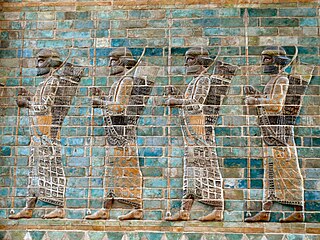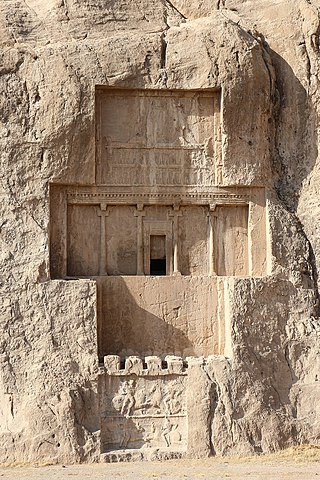
Naqsh-e Rostam is an ancient archeological site and necropolis located about 13 km northwest of Persepolis, in Fars Province, Iran. A collection of ancient Iranian rock reliefs are cut into the face of the mountain and the mountain contains the final resting place of four Achaemenid kings, notably king Darius the Great and his son, Xerxes. This site is of great significance to the history of Iran and to Iranians, as it contains various archeological sites carved into the rock wall through time for more than a millennium from the Elamites and Achaemenids to Sassanians. It lies a few hundred meters from Naqsh-e Rajab, with a further four Sassanid rock reliefs, three celebrating kings and one a high priest.

Naqsh-e Rajab is an archaeological site just west of Istakhr and about 5 km north of Persepolis in Fars province, Iran.

Kush was a satrapy of the Achaemenid Empire. The territory was conquered from the Kingdom of Kush. Herodotus mentioned an invasion of Kush by the Achaemenid ruler Cambyses II. By some accounts Cambyses succeeded in occupying the area between the first and second Nile cataract, however Herodotus mentions that "his expedition failed miserably in the desert.". Achaemenid inscriptions from both Egypt and Iran include Kush as part of the Achaemenid empire. For example, the inscription of Darius the Great on his tomb at Naqsh-e Rostam mentions Kūšīyā among the territories being "ruled over" by the Achaemenid Empire. Derek Welsby states "scholars have doubted that this Persian expedition ever took place, but... archaeological evidence suggests that the fortress of Dorginarti near the second cataract served as Persia's southern boundary." The Book of Esther describes Ahasuerus as ruling an Empire that extended from Hodu to Kush.

Kay Bahman or Wahman is a mythological figure of Greater Iranian legend and lore. The stock epithet Kai identifies Bahman as one of the Kayanian kings of Iranian oral tradition.

A necropolis is a large, designed cemetery with elaborate tomb monuments. The name stems from the Ancient Greek νεκρόπολις nekropolis.

Aspathines was a senior official under Darius the Great and Xerxes I of Persia.

A rock-cut tomb is a burial chamber that is cut into an existing, naturally occurring rock formation, so a type of rock-cut architecture. They are usually cut into a cliff or sloping rock face, but may go downward in fairly flat ground. It was a common form of burial for the wealthy in ancient times in several parts of the world.

Achaemenid architecture includes all architectural achievements of the Achaemenid Persians manifesting in construction of spectacular cities used for governance and inhabitation, temples made for worship and social gatherings, and mausoleums erected in honor of fallen kings. Achaemenid architecture was influenced by Mesopotamian, Assyrian, Egyptian, Elamite, Lydian, Greek and Median architecture. The quintessential feature of Persian architecture was its eclectic nature with foreign elements, yet producing a unique Persian identity seen in the finished product. Achaemenid architecture is academically classified under Persian architecture in terms of its style and design.

The tomb of Darius the Great (or Darius I) is one of the four tombs for Achaemenid kings at the historical site of Naqsh-e Rostam, located about 12 kilometres (7.5 mi) northwest of Persepolis in Iran. They are all situated at a considerable height above ground-level.
Naqsh-e Rostam Rural District is in the Central District of Marvdasht County, Fars province, Iran. Its capital is the village of Hajjiabad.
Hajjiabad is a village in, and the capital of, Naqsh-e Rostam Rural District of the Central District of Marvdasht County, Fars province, Iran.
Khalaf Tahuneh is a village in Naqsh-e Rostam Rural District, in the Central District of Marvdasht County, Fars Province, Iran. At the 2006 census, its population was 1,196, in 291 families.
Hoseynabad is a village in Naqsh-e Rostam Rural District, in the Central District of Marvdasht County, Fars Province, Iran. At the 2006 census, its population was 703, in 155 families.
Shamsabad-e Borzu is a village in Naqsh-e Rostam Rural District, in the Central District of Marvdasht County, Fars Province, Iran. At the 2006 census, its population was 1,302, in 322 families.
Zangiabad is a city in the Central District of Marvdasht County, Fars province, Iran.

Shapur I's victory relief at Naqsh-e Rostam is located 3 kilometers north of Persepolis. It is one of eight Sasanian rock carvings cut into the cliff beneath the tombs of their Achaemenid predecessors.

The DNa inscription is a famous Achaemenid royal inscription located in Naqsh-e Rostam, Iran. It dates to c. 490 BCE, the time of Darius the Great, and appears in the top-left corner of the façade of his tomb.

The Zvenigorodsky seal, sometimes dubbed "Persian king and the defeated enemies", is an Achaemenid cylinder seal made from chalcedony, and housed in the Hermitage Museum of Saint Petersburg, Russia since 1930, when it was acquired from a private collection. It is the so-called "Zvenigorodsky seal", it was acquired in Kerch, and first appears in the 1881 Compte rendu de la Commission Impériale Archéologique pour l'Année 1881.

The Tomb of Xerxes I is a catacombs located in Marvdasht. This tomb is part of the Naqsh-e Rostam and is Xerxes I's Tomb.

The Tomb of Darius II are Catacomb located in Marvdasht.This tomb is part of the Naqsh-e Rostam.


























